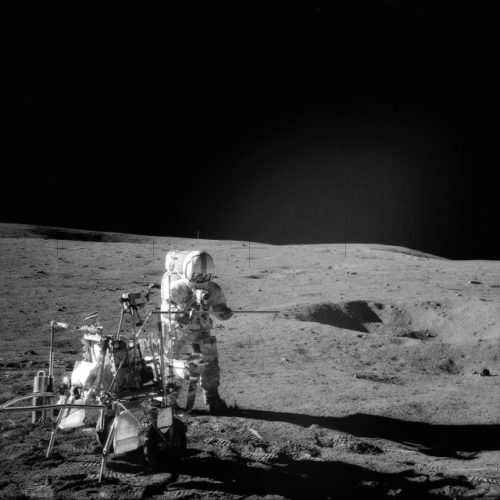
“A long way, but we’re here,” were Shepard’s figuratively and literally appropriate words when he became the fifth man to set foot on the Moon. Photo Credit: NASA
Fifty years ago, as the United States and the world stood on the cusp of launching the first humans to the surface of another world, a strange thing happened. By May 1969, three astronauts had already reached and circled the Moon, another three were only days away from conducting a full dress rehearsal of the complete Apollo spacecraft in lunar orbit and yet others were deep into training to walk on its dusty surface. Then, on 7 May 1969, NASA made an announcement which would lead to one of the Mercury Seven—America’s inaugural class of astronauts—actually setting foot on the Moon.
The astronaut concerned was 45-year-old Alan Shepard, the first U.S. spacefarer, and his unexpected return to flight status and eventually command of Apollo 14, the third manned lunar landing mission, would mark him out to be the oldest human ever to walk on the lunar terrain. But with only 15 minutes’ of previous spaceflight experience, Shepard’s qualification for Apollo 14 was regarded with some scepticism. On one occasion, when veteran astronaut Charles “Pete” Conrad saw Shepard, he offered the tongue-in-cheek remark: “Here comes the rookie!”
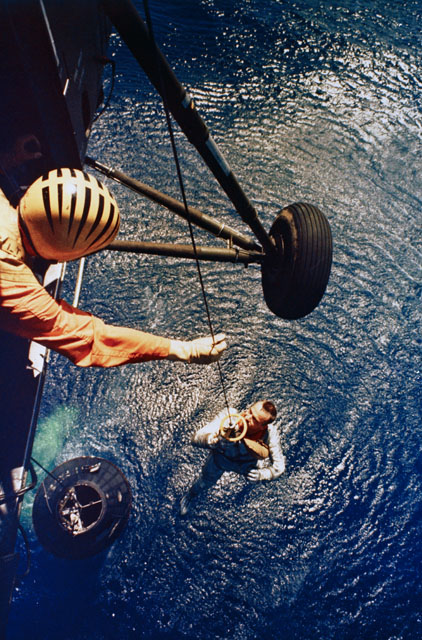
Shepard is winched to safety in the minutes after Freedom 7 splashed into the Atlantic Ocean in May 1961. For the next several years, Shepard’s astronaut life would be mired with frustration. Photo Credit: NASA
Earlier in 1969, Shepard had strode into the office of his fellow Project Mercury classmate Deke Slayton—the man in charge of picking crews for space missions—and announced that he wanted a flight to the Moon. Had any other astronaut made such a declaration, Slayton’s response would have been a severe verbal roasting, but he and Shepard were close friends and shared the unenviable bond of having both been grounded from flying not only spacecraft, but also aircraft, for the better part of a decade. Slayton had suffered a persistent heart murmur which ended his chances of flying in Project Mercury, whilst Shepard might have commanded the first Gemini mission, but for the gradual onset of an inner-ear ailment during the spring of 1963. In Light This Candle, his biographer Neal Thompson described the symptoms as a loud metallic ringing in his ears, accompanied by dizziness and nausea.
As the episodes grew in severity, Shepard was forced to submit to medical tests, which diagnosed a build-up of fluids in the semicircular canals of his inner ears, affecting his sense of balance and inducing vertigo, nausea, hearing loss and intense aural ringing. Known as Ménière’s Disease, its formal defining criteria would not be established until 1972, but its crippling severity could not be underestimated; Shepard would be virtually deaf in one ear by 1968. Nowadays, the condition is treatable through vestibular training, stress reduction, hearing aids, low-sodium diets and antihistamines, anticholinergics, steroids and diuretics, but in the early 1960s the was no cure. Some doctors even suspected it to be a “psychosomatic” affliction.
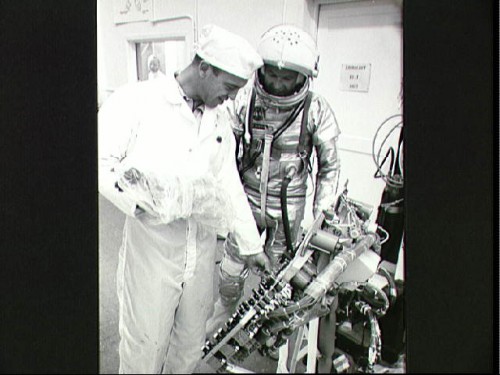
Shepard (left) and Cooper during Project Mercury days. The two men would vie strongly for command of an Apollo lunar mission in 1969. Photo Credit: NASA
In the summer of 1963, Shepard was briefly restored to flight status, but grounded the following October, when early diagnoses were confirmed and no sign of long-term improvement was forthcoming. He could not fly NASA jets, unless accompanied by another pilot. From early 1964 until the beginning of summer 1969, Shepard assumed duties as chief of the astronaut office, with a close-to-zero chance of ever flying in space again. Additionally, he dabbled in dozens of lucrative business ventures, remarking to one journalist that “all of it”—the wealth, the business activities, the spaceflight, the fame—was important to him, but the thin sliver of one day riding a rocket again incomparably topped it all.
At length, in early 1968, fellow astronaut Tom Stafford told him of an ear, nose and throat surgeon in Los Angeles, Calif., named Dr. Bill House, who was experimenting with techniques to cure Ménière’s Disease. Under an assumed name, Shepard underwent a procedure at St. Vincent’s Hospital, which entailed an incision into his mastoid bone and into part of his inner ear known as the “sacculus”, where endolymph fluid resides. It was excessive pressure and inflammation of the sacculus which had disrupted the delicate balance of Shepard’s inner ear. After cutting into the sacculus, House inserted a thin rubber tube which, if the operation were a success, would drain excessive endolymph fluid into the spinal column. By removing the source of pressure and causing the fluid to dissipate over a wider area, it was hoped that the surgical “endolymphatic shunt” would do the trick.
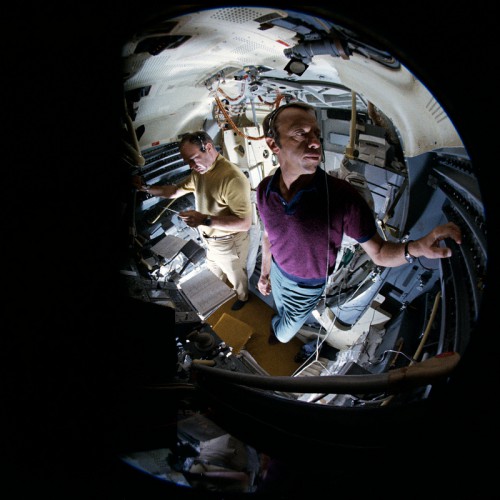
Al Shepard (foreground) and Ed Mitchell, pictured in the Lunar Module (LM) simulator during Apollo 14 training. Photo Credit: NASA
Bandaged, Shepard returned to the Manned Spacecraft Center (MSC) in Houston, Texas, in late May 1968, and over the following months his hearing gradually returned, as did his balance. Spaceflight historian Andrew Chaikin, in his book A Man on the Moon, noted that “Big Al” started showing up to simulator training runs more frequently and showed an above-average interest in the workings of the Apollo spacecraft. However, Deke Slayton’s policy was to assign a team of astronauts to backup duty in the first instance, after which the door was open for them to rotate into a prime slot, three missions later. In early May 1969, as Apollo 10 was readied to fly, its backup commander—veteran Mercury and Gemini astronaut Gordo Cooper—confidently expected that he would rotate into the still-to-be-named crew for Apollo 13, then planned to launch in the late spring of 1970.
However, for a variety of reasons, Cooper’s star had dimmed in the astronaut office and participating in a 24-hour road race in Daytona Beach, whilst in dedicated mission training, did not aid his chances of securing the Apollo 13 command. Elsewhere, by March 1969 Shepard had passed NASA’s physical, requalified for a Class I pilot’s licence and on 7 May regained eligibility for assignment to a space mission. “Shepard’s health has remained excellent during the past year, and consultant ear specialists consider his former problem no longer presents a threat of recurring suddenly,” said Dr. Chuck Berry, then-head of Medical Research and Operations at the MSC. “He is, therefore, medically qualified to return to full piloting duty.”
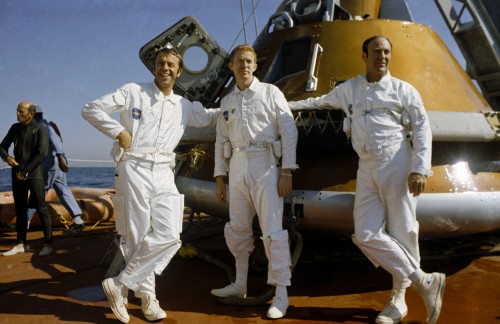
The Apollo 14 crew, pictured during water survival training in October 1970. From left are Al Shepard, Stu Roosa and Ed Mitchell. Photo Credit: NASA
As soon as he heard the news, Shepard asked Slayton to give him command of Apollo 13, the next available vacant mission slot. In a sense, acquiescing to the request made life easier for Slayton, who felt no obligation—technically, morally or otherwise—to stick to the three-flight rotation and give the command to Cooper. But on the other hand, Shepard had been out of the training game for several years and needed additional time. Cooper felt cheated, although Chaikin remarked that he had allowed Apollo 13 to slip from his grasp. In any case, Slayton later admitted that, even if Shepard had not been available, his first choice to command Apollo 13 was veteran Jim Lovell, fresh from backup duty on the historic Apollo 11 mission.
Several astronauts, Cooper included, were vocal in their discomfort at having Shepard train for a lunar landing mission with only a few months’ notice. As a result, on 6 August 1969, NASA announced the crews for Apollo 13 and Apollo 14, scheduled to occur in April and October of the following year; Lovell would command 13 and Shepard would lead 14, affording America’s first man in space additional time to prepare. Joining Shepard would be Stu Roosa as Command Module Pilot (CMP) and Ed Mitchell as Lunar Module Pilot (LMP). Mitchell had previously served with Cooper on the Apollo 10 backup team, whilst Roosa—having turned in a sterling performance in Mission Control during Apollo 9—had seized managers’ attention and admiration.
Yet the fact remained that, with Roosa and Mitchell as-yet unflown, and Shepard with barely 15 minutes of suborbital flight from his Mercury mission under his belt, the astronauts of Apollo 14 were the least-experienced crew ever to go to the Moon. The eventual success of their mission testified not only to their capabilities, but to Shepard’s own triumph over adversity. Indeed, in early February 1971, his first words after traveling a quarter-million miles across cislunar surface and setting his feet onto the dusty surface of the Moon were entirely fitting to metaphorically represent his personal and professional journey.
“It’s been a long way,” Shepard breathed, as he became the fifth human to walk on another world, “but we’re here.”
FOLLOW AmericaSpace on Facebook and Twitter!
Missions » Apollo »



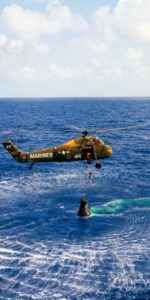
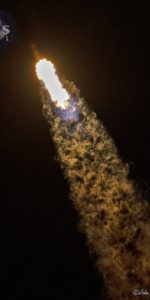
A true American hero and legend. Quite amazing that he mastered the intricacies of a moon landing mission with such little relative spaceflight experience.